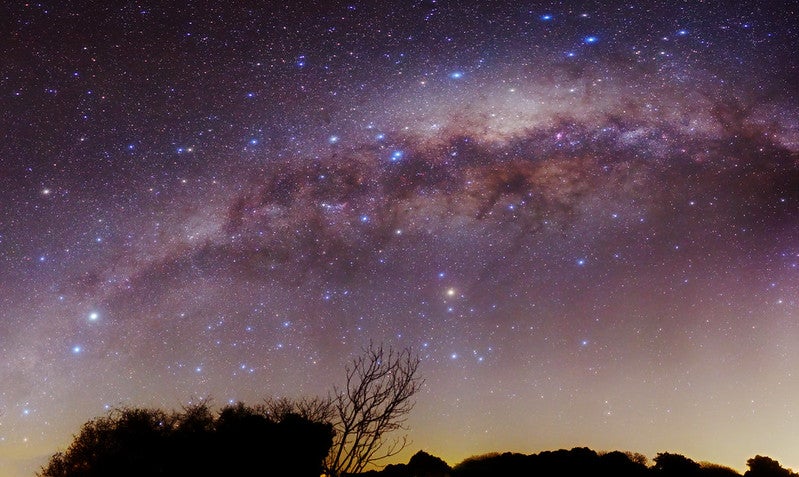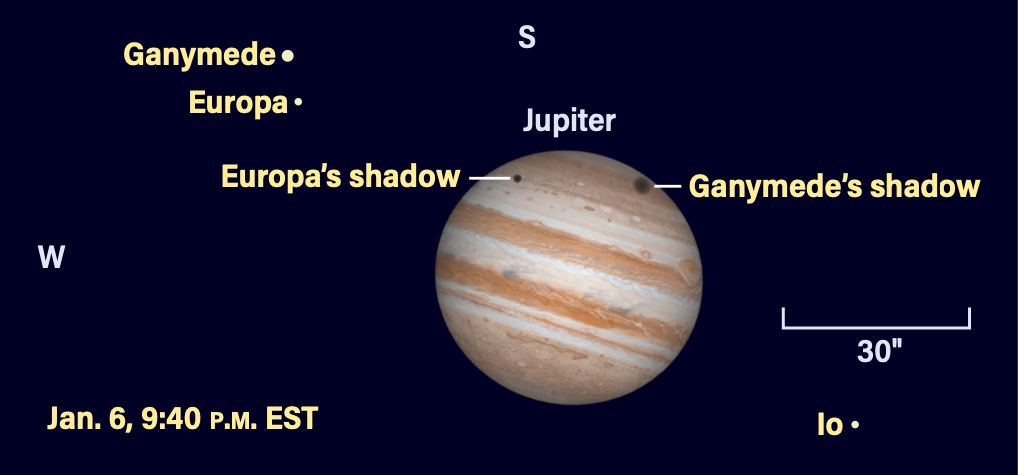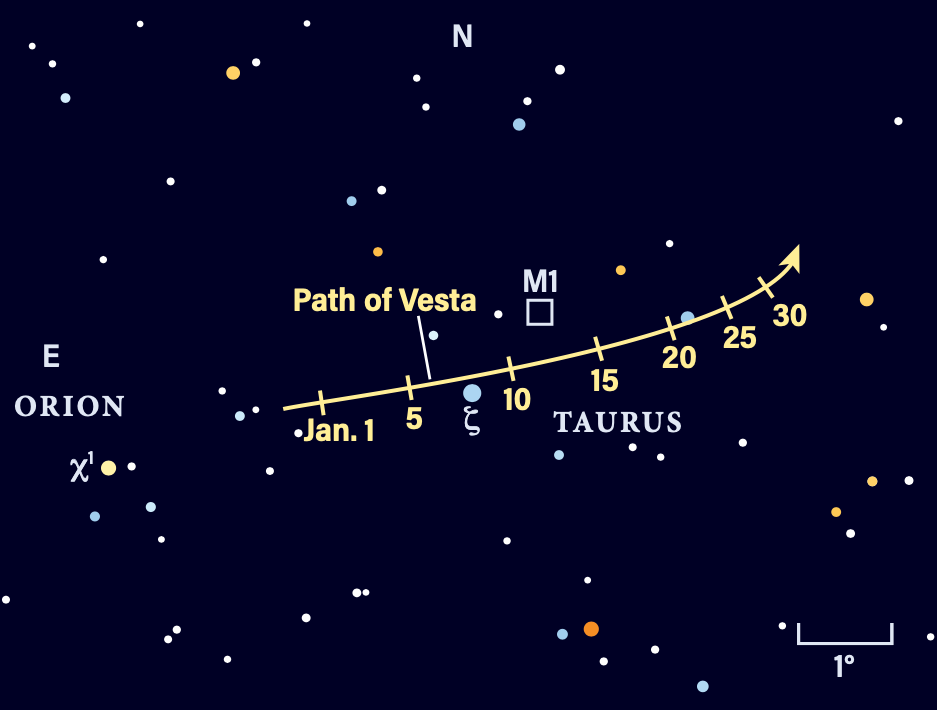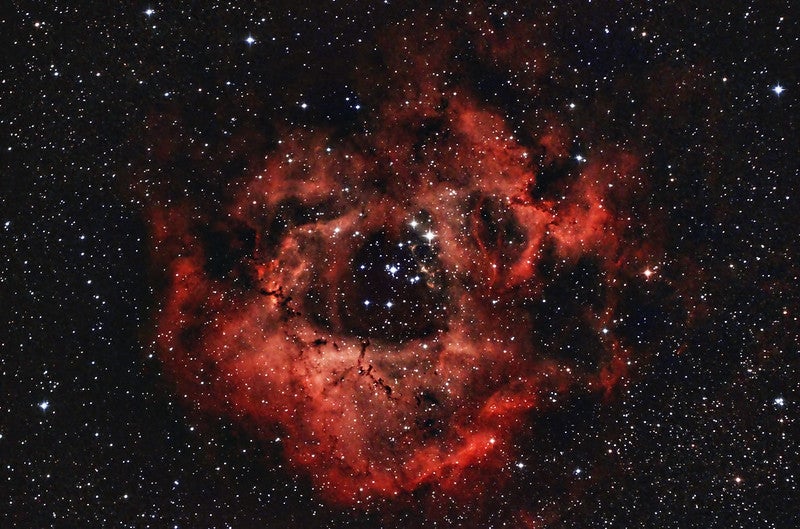
Friday, January 5
The mighty ringed planet Saturn remains a fixture in the southwestern sky after sunset, shining at magnitude 0.9. You’ll find it still 30° high an hour after sunset, to the upper right of a relatively bright star that sits about half as high above the horizon — that’s Fomalhaut, the magnitude 1.2 alpha star of Piscis Austrinus the Southern Fish.
Through a telescope, Saturn’s disk stretches 16″ across, with its rings just over twice that width. Those rings are tilted 9° to our line of sight, still showing off their northern side before next year’s ring plane crossing.
With no Moon in the sky, try to catch Saturn during the window starting after the sky is dark but before the planet sinks too low. You might spot several of its moons clustered nearby. The brightest at roughly magnitude 9 is Titan, which sits just southeast of the planet. It passes south of the gas giant overnight and will be southwest of the world tomorrow. Also visible may be 10th-magnitude Tethys, Rhea, and Dione. Tethys sits west of Saturn, about 17″ from the western tip of the rings, Rhea is close to the disk and slightly northeast, while Dione is just south of the eastern tip of the rings. Even fainter moons are also present, but you’ll need a large telescope to see them. Iapetus, now a challenging 12th magnitude, reaches its eastern elongation tomorrow and sits a whopping 7.7′ east of Saturn tonight.
Sunrise: 7:22 A.M.
Sunset: 4:49 P.M.
Moonrise: 1:21 A.M.
Moonset: 12:15 P.M.
Moon Phase: Waning crescent (35%)
*Times for sunrise, sunset, moonrise, and moonset are given in local time from 40° N 90° W. The Moon’s illumination is given at 12 P.M. local time from the same location.

Saturday, January 6
Venus passes 6° north of the bright star Antares at 3 A.M. EST. You can catch the pair about an hour before sunrise in the southeast, when magnitude –4 Venus appears just to the upper left of the magnitude 1.1 star. It’s a lovely pairing, particularly because of Antares’ deep red color. This aging star has cooled down as its fuel runs low, lending it a ruby hue.
Adding to the sight, the delicate crescent Moon (just less than 30 percent lit) lies in Libra, to Venus and Antares’ upper right. The scene is an appealing one for astrophotographers as morning twilight begins to color the sky and the trio rises higher. The Moon will track east and pass close to both Antares and Venus in just a few days, so stay tuned to the morning sky for more.
If you prefer observing in the evening, there’s some action for you tonight as well: The Galilean moons Europa and Ganymede are transiting the face of Jupiter. The event is underway at sunset in the Midwest, when Jupiter is high in the southeast. By 5:50 P.M. EST, Ganymede is just finishing its transit, about to slip off the southwestern limb of the planet. Europa is not yet halfway across, making its way from east to west south of Jupiter’s equator. It will finally exit the disk just before 7:30 P.M. EST, following Ganymede and pulling away to the west.
Keep watching and you’ll catch Europa’s shadow appear on the cloud tops not long after, around 7:40 P.M. EST. Nearly two hours later, Ganymede’s much larger shadow joins it at 9:20 P.M. EST. The shadow is so large that it takes some 10 minutes to fully appear against the disk. The dark blot will then take almost two hours to cross Jupiter’s southern polar region.
Sunrise: 7:22 A.M.
Sunset: 4:50 P.M.
Moonrise: 2:25 A.M.
Moonset: 12:40 P.M.
Moon Phase: Waning crescent (26%)
Sunday, January 7
Colorful stars can be a delight to observe, particularly when they come in contrasting sets. If you’re willing to stay out over the course of a few hours this evening, you can check out two particularly popular pairs: the famous star Albireo in Cygnus and its wintertime counterpart 145 Canis Majoris.
Let’s start with Albireo itself, cataloged as Beta (β) Cygni. You’ll want to observe this one first, as the Swan is setting in the west as the sky grows dark after sunset. Albireo marks the head of the graceful bird as it flies through the sky; the bright star Deneb (Alpha [α] Cyg) is the Swan’s tail. Ninety minutes after sunset, Albireo is roughly 20° high. It glows at magnitude 3.1, readily visible to the naked eye. Pull out a telescope and you’ll discover not one but two stars, separated by about 35″. The brighter sun shines golden yellow, while the fainter star is a hotter blue-white. Their stunning color contrast is readily visible to most observers.
A few hours later, around 9:30 P.M. local time, Cygnus has set but the stars of Canis Major have climbed high enough in the southeast to track down the so-called Winter Albireo. 145 Cma is fainter than Albireo at magnitude 4.8; it lies 3.5° northeast of magnitude 1.8 Wezen (Delta [δ] Cma) and about 10° east-southeast of Sirius, the brightest star in the northern sky. This beautiful double star looks much like Albireo, with a cooler but brighter yellow-orange primary and a hotter secondary of blue-white. This pair is slightly closer, roughly 27″ apart — still easy to split with most instruments.
Sunrise: 7:22 A.M.
Sunset: 4:50 P.M.
Moonrise: 3:34 A.M.
Moonset: 1:12 P.M.
Moon Phase: Waning crescent (17%)
Monday, January 8
Now it’s the Moon’s turn to visit Antares in Scorpius, passing just 0.8° north of the star at 10 A.M. EST. The Moon then passes 6° south of Venus at 3 P.M. EST.
Again, early morning is time to observe this scene. Look southeast around 6:15 A.M. local time to find the trio 12° high and rising as the sky starts to lighten with the coming dawn. The Moon is now just a sliver of light, roughly 11 percent lit with only its western limb illuminated as it wanes toward New. It sits about 1° from Antares, directly between this star and nearby magnitude 2.9 Sigma (σ) Scorpii. About 5.7° north-northeast of the Moon is Venus, just waiting for Luna to slip due south in a few hours.
Take out a telescope for a more detailed view. On the Moon, you may be able to spot the small, dark round blot of Grimaldi Crater near the terminator that separates lunar night from day. Venus is also an excellent target, presenting an 80-percent-lit face that is a hefty 14″ across. Even as the stars begin to fade, bright Venus will continue to stand out — in fact, observing the planet in the brightening sky often offers a better view because of the lower contrast. Just take care to put away any optics well in advance of sunrise from your location, which may differ slightly from the time given at our standard location below.
Sunrise: 7:22 A.M.
Sunset: 4:51 P.M.
Moonrise: 4:44 A.M.
Moonset: 1:53 P.M.
Moon Phase: Waning crescent (10%)
Tuesday, January 9
Continuing its trek across the ecliptic, the Moon passes 7° south of Mercury at 2 P.M. EST. Mercury, too, is a morning planet, so you’ll need to be up early to catch this pairing as well.
Look southeast an hour before sunrise and the first thing you’ll likely spot is again bright Venus. It’s the brightest thing in the sky! Drop down closer to the horizon and a little to the left to find the 5-percent-illuminated Moon and, to its upper left, magnitude –0.1 Mercury. The solar system’s smallest planet spans just 7″ on the sky, but through a telescope will readily show off its roughly half-lit (56 percent) face.
As you enjoy the scene, note the distance between Mercury and Venus. They are now 12.5° apart, but will move slightly closer day by day until the 17th, when they stand 11° apart. It can be hard to notice subtle motion one day at a time, so consider taking a shot of the morning sky as dawn approaches and then doing so again every day or two for the next week. Comparing your photos over time may better show the planets’ motion as they close in.
Sunrise: 7:22 A.M.
Sunset: 4:52 P.M.
Moonrise: 5:55 A.M.
Moonset: 2:45 P.M.
Moon Phase: Waning crescent (4%)

Wednesday, January 10
The Moon passes 4° south of Mars at 4 A.M. EST; the Red Planet, however, is still too close to the Sun and not yet visible. It should finally pop out from our star’s bright glow next week.
In the evening sky tonight, asteroid 4 Vesta is passing near the famous supernova remnant M1 in Taurus this week. Often called the Crab Nebula, this glowing tangle of gas is all that’s left of a massive star. Its explosive end was seen by astronomers on Earth in the year 1054.
Let’s start by finding 3rd-magnitude Alheka (Zeta [ζ] Tauri), already 40° high in the east two hours after sunset. This star marks the tip of Taurus’ southern horn, while Elnath marks the northern horn’s tip. M1 lies just 1° northwest of Alheka and tonight Vesta sits roughly between them, about 30′ northwest of Alheka.
Vesta is 7th magnitude, about a full magnitude brighter than the magnitude 8.4 Crab. The two look quite different, with the asteroid resembling a faint star and the nebula more a thumbprint smear of grayish-white light. If you have trouble spotting M1 where you think it should be, try shifting your gaze to the edge of your eyepiece without physically moving your telescope. The nebula’s soft glow may pop out in your peripheral vision; this is called averted vision, and it helps because the light-sensitive cells in your eye are located on the sides, while the color-sensing cells (which need more light to register an object) are in the center. Thus, looking directly at faint objects can make them more difficult to see.
Come back to this field over the next several nights to watch Vesta move slowly west-northwest, sliding due south of M1 on the 12th.
Sunrise: 7:22 A.M.
Sunset: 4:53 P.M.
Moonrise: 7:00 A.M.
Moonset: 3:49 P.M.
Moon Phase: Waning crescent (1%)

Thursday, January 11
New Moon occurs at 6:57 A.M. EST, leaving the heavens dark and perfect for deep-sky observing.
Let’s look to Monoceros the Unicorn tonight, which houses the Rosette Nebula. You’ll find the Rosette some 50° high in the south by 10 P.M. local time; it sits just 2° east of magnitude 4.4 Epsilon (ϵ) Monocerotis. The Rosette itself stretches more than 1° across and surrounds the young star cluster NGC 2244. The cluster has a collective magnitude of 4.8, making it an easy target: Even a small scope from a dark site should show more than two dozen stars. Moving to larger apertures will increase this number to more than 100 young suns.
But what about the Rosette? This gaseous, petal-like gas complex is made up of several different regions, all sporting different catalog numbers. As a whole, the Rosette is best seen with a large telescope (10 inches or more) and lower magnification (around 50x). Use an OIII or nebula filter to cut down on the stars’ brightness and bring out the nebula’s gauzy glow. Alternatively, smaller apertures can work well when coupled with a camera — stacked or long exposures will help reveal what the eye cannot see in smaller instruments.
Sunrise: 7:22 A.M.
Sunset: 4:55 P.M.
Moonrise: 7:56 A.M.
Moonset: 5:04 P.M.
Moon Phase: New
Friday, January 12
Mercury reaches its greatest western elongation from the Sun at 10 A.M. EST, when it is 24° from our star. Check out the planet an hour before sunrise, where it now stands 11.7° east of Venus in the southeastern sky. Through your telescope, you’ll notice that Mercury’s illuminated face has grown from earlier in the week — it’s now 63 percent lit and magnitude –0.2, just slightly brighter than the last time we observed it.
Venus now sits level with Antares, 9°to the left (east-northeast) of the red giant star. There are several other bright stars visible in the early-morning sky as well, lingering until the impending sunrise blots them from view. Altair, Lyra, and Deneb — the stars of the Summer Triangle — are rising in the east, to the left of Venus and Mercury. Vega is highest, with Deneb to its lower left and Altair to its lower right, closest to the horizon. Far above Venus and just slightly to the right is Arcturus in Boötes; to the lower right of this star is Spica in Virgo.
Sunrise: 7:21 A.M.
Sunset: 4:56 P.M.
Moonrise: 8:42 A.M.
Moonset: 6:23 P.M.
Moon Phase: Waxing crescent (2%)

Sky This Week is brought to you in part by Celestron.









